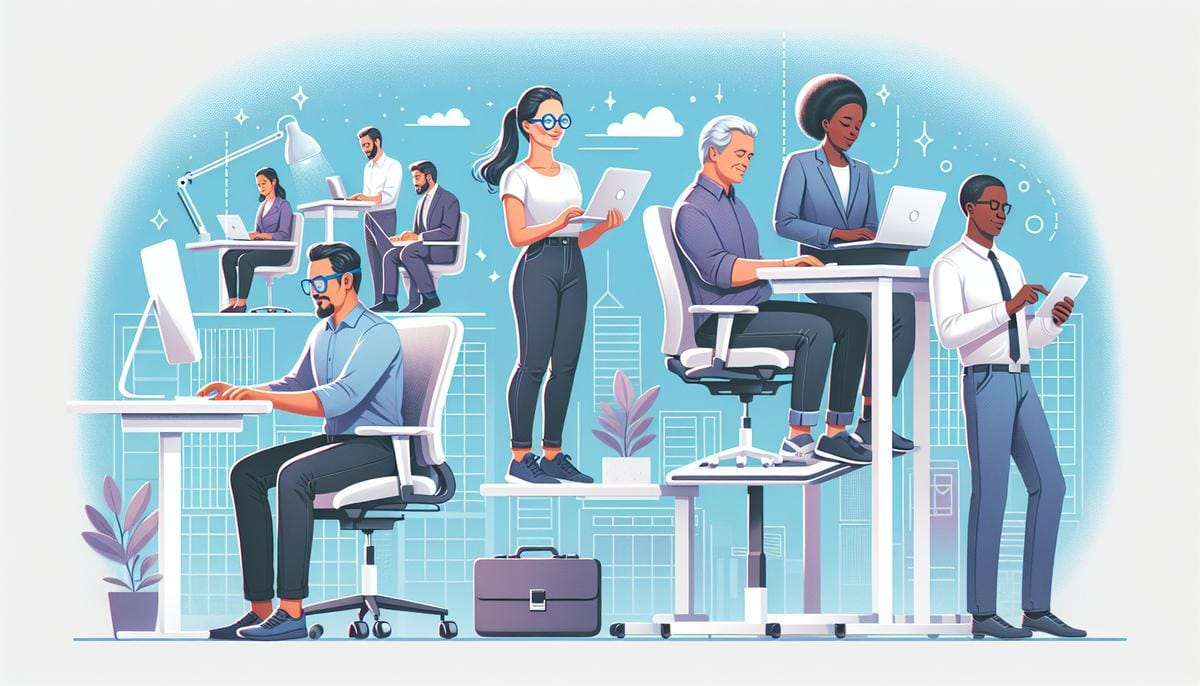The Importance of Ergonomics in Tech Usage

Introduction
Welcome, tech enthusiasts, remote workers, and all who spend their days (and sometimes nights) in front of a screen! Our topic today is one that often gets overlooked but is crucial to your well-being and efficiency – the importance of ergonomics in technology usage. As we delve into the world where comfort meets functionality, prepare to revolutionize the way you engage with your digital devices. We promise, once you go ergonomic, you never go back. So straighten up, tune in, and let's enhance the way you work and play with technology!
What is Ergonomics?
Let's break it down – the term ergonomics stems from the Greek words "ergon" meaning work, and "nomoi" meaning natural laws. It's essentially the scientific study geared towards understanding how humans interact with other elements of a system. The objective? To optimize human well-being and the overall system performance. When applied to technology, ergonomics focuses on designing and arranging your devices and workspaces in a way that fits you and your movements. This can include how you sit at your desk, how your keyboard is positioned, and even how you hold your phone. Good ergonomics can help prevent the strain and discomfort that often accompanies the repetitive movements of technology usage, making it a critical component of your daily tech life.
The Health Hazards of Poor Ergonomics
Ignore ergonomics, and you're setting yourself up for a world of pain – quite literally. Poor ergonomic practices can result in a slew of health complications. Repetitive strain injuries (RSIs), such as carpal tunnel syndrome, tendinitis, and trigger finger, are common among individuals who do not use ergonomic principles in their tech setups. And it's not just your wrists at risk; improper ergonomics can lead to chronic neck and back pain, eye strain, headaches, and even long-term musculoskeletal disorders. Such conditions can not only cause discomfort and pain but also lead to significant downtime and medical expenses. Understanding and implementing proper ergonomics can help reduce these risks, making your tech experience more pleasant and sustainable.
Ergonomic Tips for Your Tech Lifestyle
Luckily, there are simple yet effective measures you can take to make your tech usage more ergonomic. Starting with your chair, choose one that supports the natural curve of your spine. Your feet should rest flat on the ground, with your thighs parallel to the floor. When it comes to your desk, it should be at a height where your elbows are at a 90-degree angle while typing. Speaking of typing, your keyboard should be positioned so that your wrists remain flat, and don't forget to give your mouse some love – opt for one that fits comfortably in your hand and keeps your wrist in a neutral position. These ergonomic tweaks can drastically reduce the stress on your joints and muscles and can easily be implemented into your tech lifestyle with minimal effort.
The Role of Ergonomics in Productivity
Imagine this: it's mid-afternoon, you've been working for hours, and that familiar fatigue is setting in. Your concentration is waning, and your once brisk pace has slowed to a crawl. This scenario is not only frustrating but can also hit your productivity hard. This is where ergonomics swoops in to save the day. By designing your workspace to accommodate your natural movements and reduce strain, you're less likely to experience discomfort that pulls your focus from your tasks. An ergonomic setup can help you maintain a consistent work pace, reduce the need for breaks due to discomfort, and keep your mind sharp and energized throughout the day. Small adjustments to your ergonomic setup can have profound effects on your efficiency and work output.
Ergonomics and Remote Work
In today's world, more people are working remotely than ever before, and the home office has become the new battleground for ergonomic challenges. Without the standardized office setups we're accustomed to, it's easy to fall into bad habits, curling up on the couch with a laptop perched precariously on your knees, or hunched over the kitchen table on a hard, unforgiving chair. But fear not, remote workers, for you too can enjoy the benefits of ergonomics. Start by designating a specific area in your home as your workspace – one that you can tailor to your ergonomic needs. Invest in a good quality chair, and if possible, an adjustable desk. Ensure your screen is at eye level to avoid neck strain, and use peripherals like keyboards and mice that support an ergonomic posture. Embrace these changes, and your home office will become a haven of productivity and comfort.
Ergonomic Tech Gadgets: A Game Changer
When it comes to ergonomics, manufacturers are way ahead of the curve—literally. They've developed a plethora of ergonomic tech gadgets designed to adapt to the human body's form and function. Let's talk about a few. Ergonomic keyboards that are split or tented reduce wrist strain by allowing a more natural hand position. Then there are vertical mice that allow you to hold your hand in a handshake position, maintaining wrist neutrality. And don't overlook monitor arms or stands that let you adjust your screen to the perfect height and distance, helping to align your head and reduce neck strain. By selectively integrating such tech into your workspace, you enhance your ergonomic environment, all while enjoying the thrill of cool, cutting-edge gadgets. It's a win-win for your health and your inner tech geek.
Software Solutions: The Ergonomic Assist
Ergonomics is not limited to just hardware. Software, too, can offer a surprising dose of ergonomic goodness. There's a multitude of programs designed to promote healthy tech habits. From reminder apps that prompt you to take breaks and stretch, to eye-strain reducing tools that adjust your screen's color temperature as the day progresses—there's a digital solution out there for most ergonomic woes. Using voice-to-text software can reduce the need for typing, and customizable interface options can decrease unnecessary mouse movement. When combined with good hardware ergonomics, these software solutions can make your tech usage more seamless and health-conscious.
Creating an Ergonomic Tech Culture
Establishing ergonomic practices isn't just an individual affair. There's a growing movement to create workplace cultures that prioritize ergonomics. Companies are recognizing the long-term health and productivity benefits of ergonomic workspaces and are investing in training, assessments, and quality ergonomic office equipment for their employees. This cultural shift isn't just about reducing sick days; it's about creating a work environment that values the health and well-being of every team member. We can all be advocates for ergonomic culture by starting conversations, sharing tips, and leading by example. Regardless of whether you're a team lead or a new recruit, your voice and actions can contribute to this positive change.
The Evolution of Tech Ergonomics
As technology evolves at breakneck speed, so too does the field of ergonomics. We stand on the brink of exciting developments that promise to seamlessly integrate ergonomics into our everyday tech use. The future holds promise for dynamically adjustable workstations that respond to our movements, wearables that correct our posture by gentle nudges, and perhaps AI-powered tools that adapt our devices in real-time for optimum comfort. These advancements suggest that the future of ergonomics in tech will not only alleviate discomfort but also proactively enhance our health and productivity in innovative ways.
Conclusion: Embrace Ergonomics for a Healthier Tech Life
And there you have it—your comprehensive guide to the why's and how's of ergonomics in tech usage. By now, you should be well-versed in the risks of poor ergonomic practices and armed with the knowledge to revamp your approach to tech tools and workspaces. It all boils down to this—embracing ergonomics is an investment in your physical well-being and your efficiency in the tech-driven landscape we inhabit. So, take the proactive step today: evaluate and enhance your tech environments, incorporate ergonomic principles into your daily routine, and set sail for a healthier, happier, and more productive tech life. Your future self will thank you for it!


